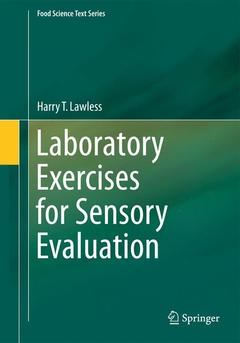Description
Laboratory Exercises for Sensory Evaluation, 2013
Food Science Text Series, Vol. 2
Author: Lawless Harry T.
Language: English
Subjects for Laboratory Exercises for Sensory Evaluation:
Keywords
Publication date: 12-2012
151 p. · 17.8x25.4 cm · Paperback
151 p. · 17.8x25.4 cm · Paperback
Description
/li>Contents
/li>Biography
/li>Comment
/li>
Laboratory exercises are a necessary part of science education. They enable students to better understand the principles discussed in lectures, and provide them with hands-on experience of the practical aspects of scientific research. The purpose of this book is to provide students and instructors with a time-tested set of lab exercises that illustrate the common sensory tests and/or sensory principles used in evaluation of foods, beverages and consumer products. The appendices will also include a set of simple problem sets that can be used to teach and reinforce basic statistical tests. Approximately twenty years ago the Sensory Evaluation Division of the Institute of Food Technologists sponsored the preparation of a set of exercises titled ?Guidelines for Laboratory Exercises for a Course in Sensory Evaluation of Foods,? edited by one of the co-authors (Heymann). This book will provide additional materials from the second author (Lawless), as well as other instructors, in a uniform format that can be easily adopted for course use. Most importantly, the lab exercises will complement the flagship textbook in the field, Sensory Evaluation of Foods: Principles and Practices, 2E, also by Lawless and Heymann and published by Springer. Possible course adoption of the main text along with the lab manual should enhance the sales of these materials.
Section A. Introductory Material and General Instructions.- 1. Introduction for Students.- 2. Introduction for Instructors and Teaching Assistants.- Section B. Eleven Laboratory Exercises in Sensory Evaluation.- 3. Screening panelists using simple sensory tests.- 4. Comparison of discrimination test methods.- 5. Forced choice thresholds using an ascending method of limits.- 6. Signal Detection Theory and the Effect of Criterion on Response.- 7. Sweetness of fructose and sucrose determined by different scaling methods.- 8. Time-intensity scaling.- 9. Flavor Profile Method.- 10. Introduction to Descriptive Analysis.- 11. Use of Reference Standard in Panel Training.- 12. Acceptance and Preference Testing.- 13. Optimization by ad libitum Mixing and the Just-About-Right Scale.- Section C: Brief Exercises and Group Projects.- 14. Group Exercise in Descriptive Analysis.- 15. Brief exercises.- Section D. Statistical Problem Sets for Sensory Evaluation.- Chapter 16: Sample Problem Sets for Statistics.- Exercise 1. Means, standard deviations, standard errors.- Exercise 2. Binomial-based statistics for discrimination tests.- Exercise 3: The t-tests.- Exercise 4. Simple Correlation.- Exercise 5. One and two-way ANOVA.- Exercise 6. Planned comparisons of means following ANOVA.- Exercise 7. Rank order tests.- Appendix. Sample data sets and open tables for calculations.
Harry T. Lawless is Professor Emeritus in the Department of Food Science, Cornell University.
Complements the flagship textbook Sensory Evaluation of Foods Easily adaptable to coursework Includes problem sets
© 2024 LAVOISIER S.A.S.




